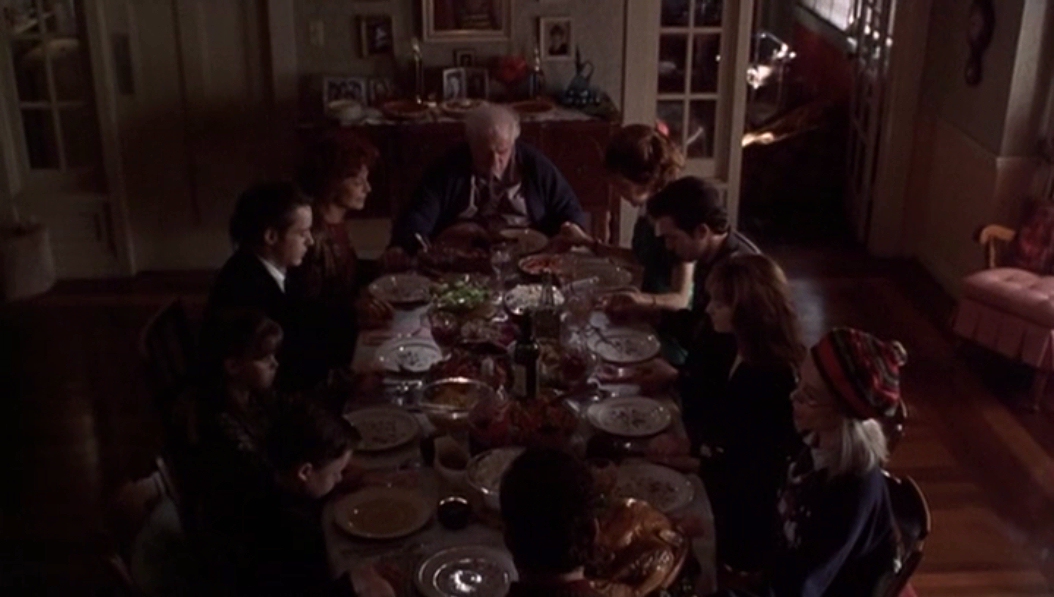shoveling the turkey and stuffing the snow
As Home for the Holidays begins for the penultimate time... and I imagine every time I finish with one of these movies for seven days that I will never see it again, this is it. It is probably not true for some of them, but it is an interesting way to think about it. Anyway, as Home for the Holidays begins for the second-to-last time, as this month of Thanksgiving-related films comes to an end, it occurs to me that I have not spent much time on the literal aspects of the holiday. I have talked about meaning, I have compared our animosity-laden relationship with our family members to the same between colonists and natives in the pre-United States America. I have talked about family gathering in general and holiday traditions in the abstract. But never the concrete.
(And this, the day after the holiday.)

The turkey, the mashed potatoes, the cranberry sauce, and whatever else crowds the table. Writing for Science News Letter back in 1951, Watson Davis explains, “Even today when all the foods of the world are available to enrich our daily diet, the Thanksgiving menu of the average household is still predominantly American in origin and production” (p. 314). Cranberries are American. Potatoes also come from the Americas, specifically Peru, but, like that parenthetical bit just now about turkeys, they made their way to Europe and then back again. Corn as well hails from the Americas. Turkeys are American (though domestic turkeys may be indirectly also non-American because some were taken to Europe and then later brought back to America). Hell, Benjamin Franklin wanted the national bird of the United States to be the turkey, not the eagle. Well, that is not true. It’s a popular version of the story but, it just is not quite accurate.
The thing is, there is no particular evidence that Franklin promoted the turkey as the national bird in any official capacity. He was on an early committee regarding the national emblem but suggested a biblical scene involving Moses. A couple committees (which he was not on) later, we had the national seal with the eagle on it. Franklin did write about the eagle and the turkey in a letter to his daughter in 1784, though he was specifically writing about the badge of the Society of Cincinnati not the national emblem. He called the bald eagle “a Bird of bad moral character.” He explained:
He does not get his Living honestly. You may have seen him perched on some dead Tree near the River, where, too lazy to fish for himself, he watches the Labour of the Fishing Hawk; and when that diligent Bird has at length taken a Fish, and is bearing it to his Nest for the Support of his Mate and young Ones, the Bald Eagle pursues him and takes it from him.
Later in the same letter, he calls the turkey “in Comparison a much more respectable Bird, and withal a true original Native of America.” I suppose if the national bird had been the turkey, then we would have eagle farmers and we would eat eagle at Thanksgiving dinner.
The original Thanksgiving feast, with the Pilgrims and the Wampanoag probably took place earlier in the year, celebrating the Pilgrim’s first harvest in America, not late November. The fourth Thursday in November became a thing in 1941 due to President Roosevelt, though Thanksgiving had been a national holiday since 1863 (and was a thing in New York, apparently, as early as 1817) and congress has made Thanksgiving decrees as far back as 1777 (according to Amanda Foreman, writing for the Wall Street Journal, 26 November 2014). The menu was never a set part of the holiday—that original Thanksgiving probably had venison as the main protein, not turkey—but somewhere along the line it became tradition. Foreman (2014) writes:
During the 19th century, the turkey’s usefulness as a cheap source of meat for a large crowd made it increasingly popular. By 1869, the writer Harriet Beecher Stowe recalled in “Old Town Folks” the Thanksgivings of the past, “the turkey, and chickens…with all that endless variety of vegetables which the American soil and climate have contributed to the table.”
The native menu had already normalized and would continue.
Airing the family’s dirty laundry—that may have been added later, or it may have always been a thing.
Comments
Post a Comment